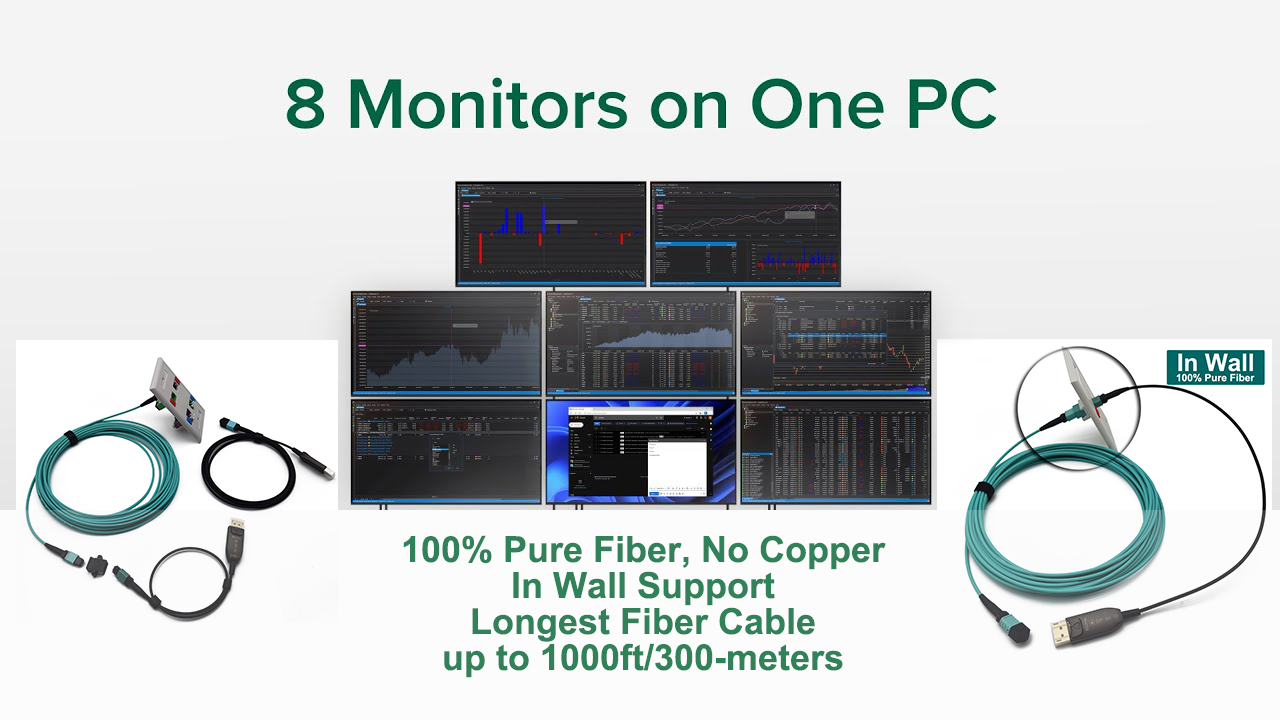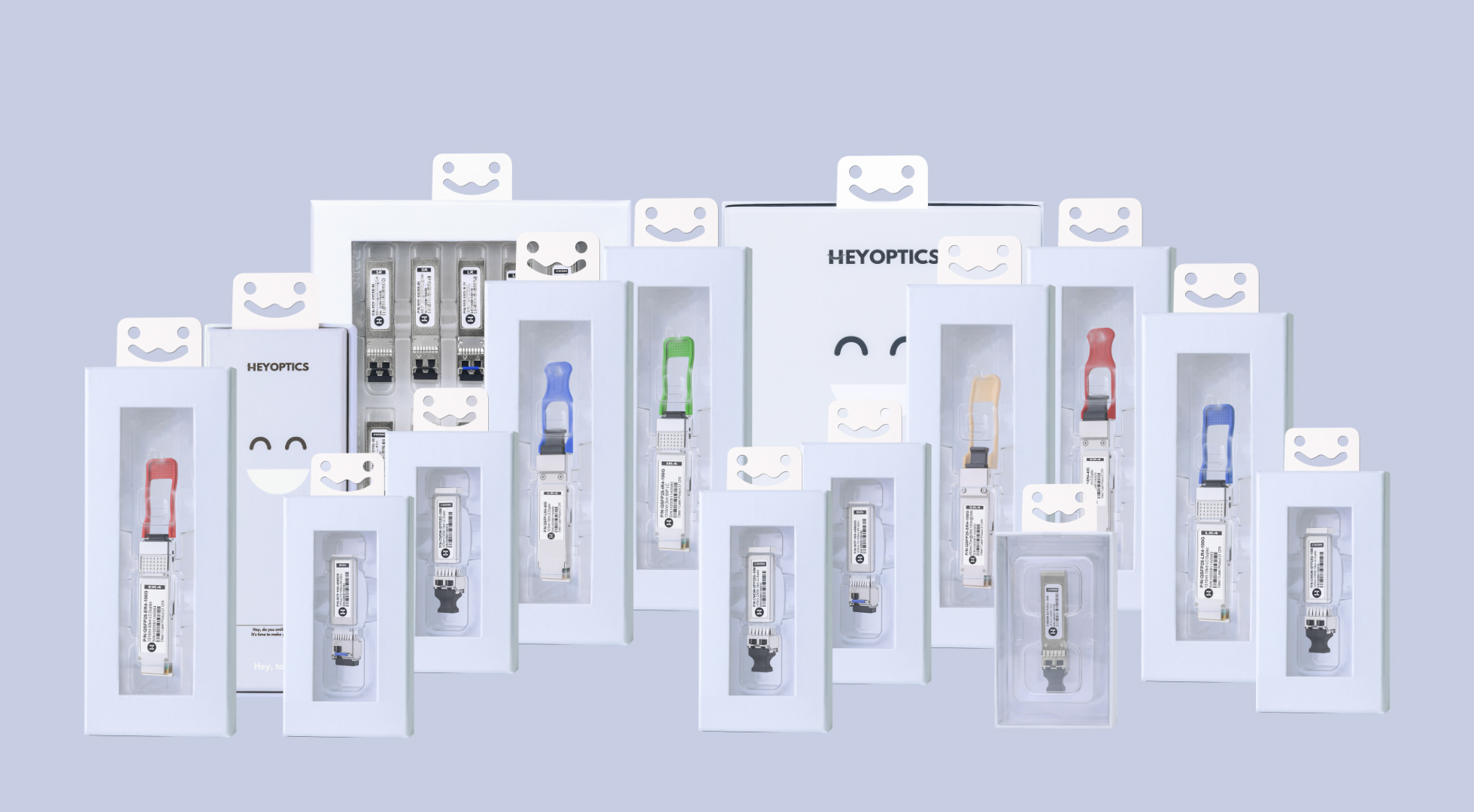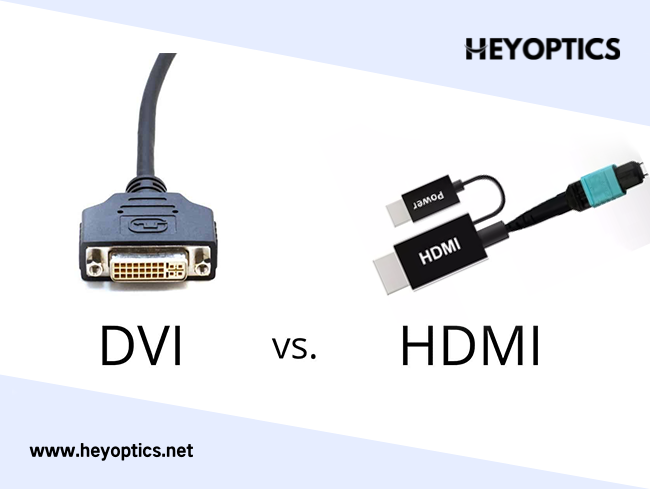4K VS 8K HDMI cables:How much do you know?
With the surge in the use of high-resolution displays worldwide, we have seen a growing need for audio/video transport to keep pace with this scalable growth. Mainstream monitors at 4K resolution have become commonplace, and as broadcasts at 8K resolution have begun in recent years, it's clear that the amount of data being transmitted around the world is growing exponentially.
Because of this, the bandwidth required for these transmissions is beyond the capabilities of traditional HDMI cables. This is due to the properties of copper cables that create greater impedance over distance, limiting the ability to transmit high-resolution signals. Therefore, the maximum length of a standard 8K HDMI copper cable is only 3 meters, which in turn has led to the introduction of fiber optic cables to the market to replace copper-based cables.
With that in mind, how does fiber optic cable relate to 4K and 8K resolutions? In this article, we explore the following questions to facilitate understanding of 4K and 8K HDMI cables.
- What is an optical HDMI cable? How do they work?
- What is 4K/8K HDMI? Which versions of HDMI cables support 4K/8K resolutions?
- What should I pay attention to when using an optical HDMI cable?
- What's unique about HDMI cables? And many more...
What are fiber optic HDMI cables? How do they work?
Fiber optic cables are distinctive because of the following characteristics:
- Fiber optic material is extremely light, which as a result drastically decreases the weight of any cable that utilizes them.
- They are very suitable for long distance transmissions, this is because the amount of data loss per kilometer in optical transmissions is so low that it that can be considered negligible. Consequently, fiber optic cables can stretch to 100 – 200 meters.
- Because their transmissions are based mainly on light, they can avoid electromagnetic interference.
What Is 4K/8K HDMI? What versions of HDMI cables support 4K/8K resolution?
In terms of the transmission speeds for the various versions of the HDMI interface, the 1080p resolution of HDMI v1.4 requires 10.2Gbps speeds, while 4K resolution for HDMI 2.0 requires 18Gbps. In the future HDMI 2.1 with its 8K resolution will require 48Gbps.
High Speed HDMI 2.0 (4K) cables
- The most crucial consideration when selecting an HDMI cable capable of supporting 4K resolution TV pictures is its speed. If it can’t convey digital signals fast enough for the requirements of your high-resolution equipment and your media sources, it simply won’t work properly.
- The speed at which data travels along an HDMI cable is measured in gigabits per second (Gbps). To spare you the headache of memorizing a raft of different numbers has simplified cable speeds into four kinds.
- If you’re not yet the proud owner of a 4K resolution TV and you don’t intend on becoming one any time soon, the ‘Standard HDMI’ cable will almost certainly suffice. It’ll work well with standard HD games consoles, Blu-ray and standard DVD players, streaming media players, and AV sound bars and receivers.
- However, if you decide to upgrade above standard HD, you may well find that you need a ‘faster’ cable to keep up with the new device’s input requirements. This is when the High Speed HDMI 2.0 cable becomes a worthwhile investment. Released in September 2013, it’s capable of conveying digital signals fast enough to deliver glorious video images on a 4K TV at 30Hz.
- A word of caution before proceeding. 4K-compatible HDMI cables are noticeably more expensive than their predecessor (HDMI 1.4), so if you’re not investing in a 4K-capable video display device, it’s simply an added expense that will not deliver any further improvement to your viewing experience. The technology that it’s designed to enable is packed into the device. Without the device, you’re simply spending extra money needlessly.
- If you possess a very high-quality version of the earlier standard (and your cable is still relatively new), you may find that you don’t need to buy a 4K-compatible cable at all. The best advice is to try it and see – if your display image flashes and flickers, you’ll need to upgrade to the 4K-compatiable HDMI 2.0 standard.
- With that said, if you are ‘going full 4K’, the benefits don’t end with the wonderfully enhanced visuals. High Speed 4K-compatible HDMI cables can support as many as 32 audio channels, with dynamic lip synch thrown in for good measure so that you never experience any irritating lags between sound and image.
- A small but significant upgrade to the HDMI 2.0 cable standard was released in April 2015. Known as ‘HDMI 2.0a’, these cables include additional support for High Dynamic Range (HDR) video displays. This delivers appreciably improved picture quality by enhancing the detail in the bright and dark regions of the image and also throws a more multifaceted range of colours into the mix.
- The information needed for the added HDR quality comes in the form of extra metadata in the HDR content itself, such as that streamed from 4K video sources via services such as Netflix or Ultra HD Blu-ray discs. HDMI 2.0a High Speed 4K-compatible cables essentially make it possible for devices to transmit and receive this quality-enhancing metadata.
- Shortly after HDMI 2.0a, and still included in the general HDMI 2.0 4K-compatible cable standard, a further minor update was released. Known as HDMI 2.0b, it added support for Hybrid Log Gamma or ‘HGL’ versions of HDR video displays.
- We’ve concentrated so far mostly on the ‘pros’ of buying a 4K-compatible HDMI 2.0. We’d be a little remiss if we didn’t also alert you to any ‘cons’.
- One of them is that these cables will usually deliver poorer-quality results if they have to traverse distances over three meters. If you need to run a cable over a greater length than that, you’re better advised to opt for an ‘active’ HDMI cable with an integral processing chip that sees to it that the signal gets smoothly from source to display without any interruption or loss of quality.
Ultra High Speed HDMI 2.1 (8K-compatible) cables
About 8K devices, and will you need an 8K-compatible HDMI 2.1 cable?
- There’s no disputing the fact that the new HDMI 2.1 standard, which was released in October 2017, constitutes a major upgrade – it packs in a colossal bandwidth capacity of 48 Gbps compared to its predecessor.
- The question is, given that many new-generation 8K devices are still in the pipeline and haven’t yet reached the retail shelves, do you need an 8K-compatible cable yet?
- These are still mainly future technologies. However, even so, there may be some reasons why purchasing one of these high-end HDMI cables now is worth the investment. These include the following.
- Your 4K Apple TV flashes or flickers. Complaints have arisen from some owners of these high-end TV sets that they keep having their viewing experience impaired by intermittent flickering or flashes of brightness – glitches that seem to occur more frequently when they’re using Dolby Vision or related HDR1O formats. Apple now advises that users can eliminate these problems by connecting to their TV sets with an 8K-compatible cable.
- You play video games in 4K. The Xbox One S 4K console, for example, has a hefty output of 60Hz. If you’re using an earlier HDMI standard such as HDMI 1.4, you’re simply not going to enjoy the benefits of 4K video quality (these cables only support 4K with 30Hz outputs). Because Ultra High Speed HDMI 8K compatible cables support refresh rates of as much as 120Hz, they can comfortably support such a high-end games console without the merest hint of a freeze or a glitch.
- You’ve invested in Dolby Atmos or DTS:X audio equipment. The latest generation of top-drawer surround-sound formats such as Dolby Atmos, DTS:X, Dolby True HD, and DTS Master) all employ HDMI eARC, or ‘Enhanced Audio Return Channel’. The earlier ARC technology (introduced in 2009) dispensed with a separate audio cable so that you could listen to your sound bar simply with an HDMI cable. The newer eARC improves on this standard with a much larger bandwidth that permits high-quality, uncompressed sound formats, mandatory lip-synch correction so that picture and sound always match perfectly with no lag, and much better HDMI link-ups between devices. However, if you own this high-end equipment, the only cable capable of doing the job is the new 8K-compatible HDMI.
- You’re wiring a home theatre. By investing in next-generation 8K-compatible HDMI cables now, you’ll be saving yourself the cost, mess, and inconvenience of doing so later when 8K devices are more ubiquitous.
- You own a Dolby Vision TV that includes 4:4:4 chroma subsampling. This is a 4K signal with a hefty 60Hz uncompressed Dolby Vision HDR that needs a massive 24.06 Gbps of bandwidth. It’ll grant you the most spectacularly detailed picture quality – but not with an HMDI 1.4 or HDMI 2.0 cable, because neither can handle that requirement.
- If you know that you’ll be investing in next-generation 8K equipment, the 8K-compatible Ultra High Speed 2.1 HDMI cable is for you.
How do fiber optics work?
The principle behind fiber optic cables is that they convert the electronic signal that is broadcast from the output end into a high-speed laser signal that is transmitted across fiber optic strands that are thinner than a human hair. Then when the signal reaches the input end the laser signals are converted back into electronic signals to be received by the display.
Though fiber optic cables help resolve the issue of long-distance transmission, in terms of compatibility the cables often have to deal with signals that have difficulty with transitions or signals that aren’t able to fully produce the type of high-quality video that high-bandwidth transmissions allow (i.e. signals that aren’t able to hit high frame rates, chroma sampling, or HDR imaging).
What should I take note of when using fiber optic HDMI cables?
When using fiber optic HDMI cables, you should take note of the following items to ensure optimal performance and prevent any problems:
1. Double-check that the specifications for the cable are correct
When reviewing the cable specifications, ask yourself the following questions: Does the cable support the right version of HDMI? Is the highest supported video bandwidth enough? What is the highest resolution that it supports? Does it support 3D video?
| Units | Transmitter (Source) | Receiver (Display) |
| HDMI Version | • HDMI2.0b, Fully Support bi-directional EDID and HDCP communication • HDCPI.4/2.2 pass through, Audio, CEC, support HEC&ARC |
|
| Video Bandwidth | 18Gbps - 6Gbps per Channel + Clock | |
| Supported Resolution &Distance | • Max. resolutions: 2160p60 4:4:4 8/1 Obit• PC: 4096x2160 @60Hz up to 100 meters • HDTV: 480p, 720p, 1080i and 1080p deep color, 4K(60P), 3DFull HD 1960x 1 080 up to 100 meters |
|
2. Double-check the direction of the input and output end connections
Fiber optic HDMI cables have a directional flow. In other words, when connecting a fiber optic HDMI cable, the transmitter end must be connected to the source device while the receiver end must be connected to the sink device.
3. Verify compatibility issues using standard copper cables
Usually, when you encounter compatibility issues while using fiber optic cables and are unable to determine if the problem is coming from either the video equipment or the cables, the best way to figure out the source of the problem is to switch the fiber optic cable with a copper cable. If switching over to a copper cable helps resolve the issue then you’ll know that the problem is related to the fiber optic cable’s specifications.
4. Ensure that the power supply is sufficient for the fiber optic cable
Because fiber optic cables are active and feature an embedded electricity-to-light converter, they require a 5V power supply that the HDMI interface can transmit. Does this mean you have to worry about whether or not your source device provides enough power for the cable? Aside from this being one of the most common questions, this question is also one of the hardest ones to tackle. First off you must check the cable’s specifications for its power consumption and then check if the power output of the source device’s HDMI_5V of HDMI port is sufficient. Using AppleTV as an example, its HDMI port power output is 500mW (5V/100mA), if your fiber optic cable features a converter that requires a power supply of over 500mW, you either will not be able to use the cable at all or the use of the cable will result in subpar resolution. The current solution to this problem is to use an additional 5V power supply adapter cable similar to the one pictured below.
5. Double-check that the connection method of the power supply adapter cable is correct
As shown in the image above, connect the transmitter end of the fiber optic HDMI cable to the female connector of the power supply adapter cable, connect the male connector of the adapter cable to the source device (such as an AppleTV), and then connect the USB male connector of the adapter cable to a USB 5V output port.
What’s unique about HDMI cables?
- HDMI is a ‘pure-digital’ interface that has fast become not only the best but also the only way to connect HDMI-equipped television sets, home theatre receivers, and sound bars to a raft of high-resolution devices such as HD-DVD and Blu-ray players, new-generation games consoles, and HD-capable satellite and cable TV set-top boxes.
- It’s a lot more than a port on the back of a TV set or the cable that fits into it – it’s a set of rules that enable high-resolution devices to communicate.
- Unlike older ‘analog’ TVs, which used a continually fluctuating (analog) electrical, which produced a compromised picture by today’s standards, modern HDTVs use information in the form of ones and zeroes that travel along specially developed cables as distinct electrical pulses (hence the term ‘digital’). The result is a far sharper and more colour-rich picture.
- Some manufacturers will seek a competitive edge by promoting their HDMI cables as nylon-braided or with other minor benefits. It’s probably wise to regard these as superficial bells and whistles. It’s the cable inside that does the digital donkey work.
- In a nutshell, that’s basically what HDMI cables share in common. However, as we mentioned earlier, there have been several different iterations of the HDMI cable over the years to keep up with rapidly changing video standards.
- The two latest versions of HDMI cables are those compatible with the latest video standards known as ‘High Speed HDMI 2.0 (capable of supporting up to 4K resolution) and ‘Ultra High Speed HDMI 2.1 (capable of supporting up to 8K resolution).
Previous
Fiber Polarity Basic



